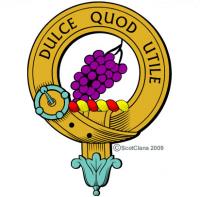
Clan Strange
The name Strange is generally found in the Scottish Lowlands, particularly in Fife, although there are some families of this name found in Orkney. It is believed that the name derives variously from the Norse Strangi, the Norman name 'étrange', meaning stranger or foreigner, or the Scots form of 'Strong'.
In Orkney the name generally takes the form Strong, while in the Lowlands it is found as Lestrange, Strange, Strang as well as Strong.
The earliest mention of name in Scotland is in 1255 being that of Home le Estraunge who was in the service of Alexander II. A William Strange is Burgess of Montrose in 1296, Thomas de Strang had land near Aberdeen in 1340 and in 1398, John Strang was elected a common councillor there.
In 1542 Sir George Strang was a cleric and notary in Orkney and in 1555 there was an advocate in Edinburgh named Richard Strange.
Strange of Balcaskie
Around 1362 John Strang married Cecelia, inheriting from her brother, Richard Anstruther of that Ilk, some of the land at Balcaskie. In 1482 John Strang of Balcaskie received a charter of confirmation for the lands of Ewington which had been exchanged by his father George Strang for the lands of Whiteside and Glenkirk. This same John Strang had a grandchild, also John, who was killed at the Battle of Pinkie Cleugh in 1547. His grandson, also John, sold the Balcaskie estate in 1615 and had a son, Thomas, who died leaving no heirs.
The current chief who was confirmed by Lord Lyon in 1995 is Major Timothy Strange of Balcaskie.
Balcaskie House in the East Neuk of Fide was remodelled by Sir William Bruce between 1665 and 1684, and is now owned by the Anstruthers,
Sir Robert Strange, born in 1721, was descended from the Stranges of Balcaskie. He had begun a career in engraving when, in 1745, he joined the Jacobite army as part of the Prince's Life Guard. After Culloden he eventually returned to Edinburgh before travelling to Europe and becoming an acclaimed artist. In 1787 he became the only engraver to receive a knighthood.






